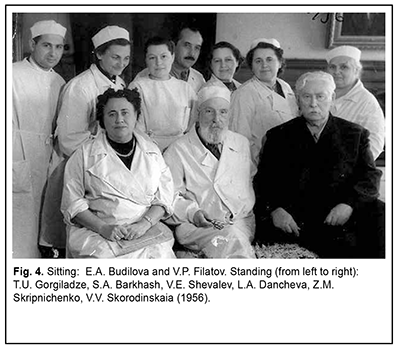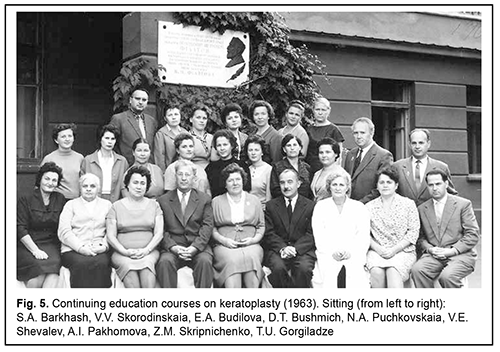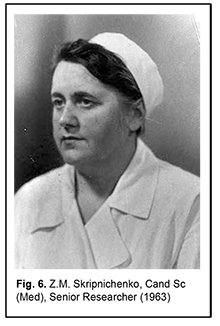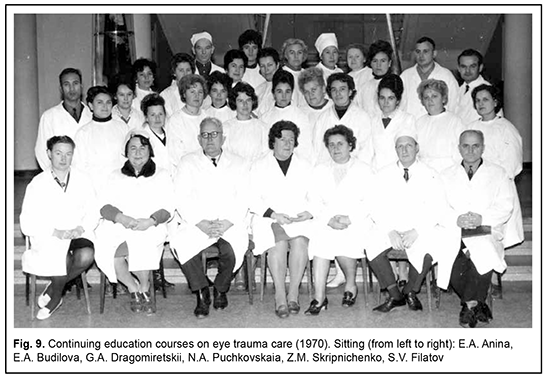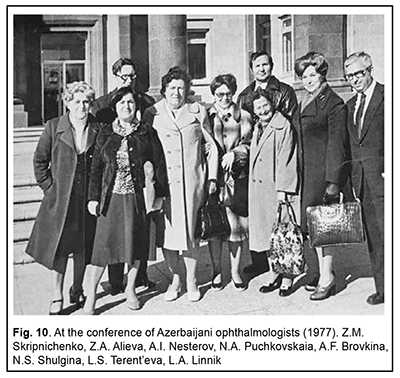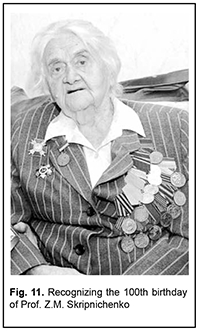J.ophthalmol.(Ukraine).2021;3:75-82.
|
http://doi.org/10.31288/oftalmolzh202137582 Received: 15 April 2021; Published on-line: 29 June 2021 Professor Zinaida M Skripnichenko, the founder of Ukrainian ocular traumatology N. F. Bobrova SI "The Filatov Institute of Eye Diseases and Tissue Therapy of the NAMS of Ukraine" E-mail: filatov.detskoe7@gmail.com TO CITE THIS ARTICLE:Bobrova NF. Professor Zinaida M Skripnichenko, the founder of Ukrainian ocular traumatology. J.ophthalmol.(Ukraine).2021;3:75-82. http://doi.org/10.31288/oftalmolzh202137582
The first Eye Emergency Station in the USSR was established on the initiative of Academician Vladimir P. Filatov at the Eye Clinic of Odessa Medical Institute in 1932 and continues to operate successfully. Subsequently, such stations were established in the Ukrainian cities of Kyiv, Kharkiv, Dniropertrovsk, and Donbass region, etc. At that time, Zinaida Skripnichenko, born in 1914 and the only daughter of Mikhail Dmitrievich and Maria Nikitichna Skripnichenko, was a young girl. The country was going through a period of revolutionary shocks, a civil war and hunger. In the terrible year of 1937, Mikhail Dmitrievich was arrested on a trumped-up “political” charge and shot by a firing squad. Zinaida got a stigma of being a “public enemy’s daughter”, and the stigma stuck to her for years, although her father was rehabilitated years later. She was a good student. While being a student, she got her first science work published and delivered a report at the conference of students across the republic. In 1940, Zinaida graduated magna cum laude from Odessa Medical Institute, and became an ophthalmology resident at the eye clinic. When the war broke out in 1941, she was mobilized into the Soviet Army and served as military physician in a Medical and Sanitary Battalion, practically on the frontline (Fig. 2). It was common that, at a surgery tent, a surgical procedure was commenced on the table and completed under the table after bombing started, with the table giving some temporary protection from shell fragments. Nervertheless, wounds were duly processed, intraocular foreign bodies removed, and surgeries concluded. Her commander characterized her as follows [1]: “Medical service captain Z.M. Skripnichenko is a highly skilled specialty doctor who knows and loves what she does. Since the first days of war she has performed about two thousand surgeries and saved sight for hundreds of injured military personnel. Being a member of the groups of a separate medical reinforcement company, she has been always working at bottlenecks in rush periods at the front. She displayed courage and selflessness while often giving medical care under shell fire.” Military doctor Z.M. Skripnichenko was awarded with Combat Service and Defence of the Caucasus medals and Great Patriotic War and Bogdan Khmelnytsky orders, as well as commemorative medals, plaques and honorary certificates.
Academician Filatov did not overlook his pupils in those stern times. Z.M. Skripnichenko, a young eye surgeon serving at the front, began receiving postcards through the military postal system from the academician in which he tried to cheer her up and give some pieces of advice. Moreover, he even sent her his monograph, “Tissue therapy” with the author’s inscription (Fig. 3). Later for years the academician kept providing the “public enemy’s daughter” with his support and understanding and tried to compensate her in some way for her early loss of father. After Z.M. Skripnichenko was demobilized from the army, she came back to work at the Experimental Institute for Eye Diseases (now the Filatov Institute), where she worked her way up from junior researcher to become Doctor of Science in Medicine, Full Professor and Head of the Department.
In 1965, Z.M. Skripnichenko, at that time Candidate of Medical Science and already a Senior Researcher (Fig. 6), a former military surgeon with considerable experience in the management of combat eye injuries, initiated the setting up of the Ocular Trauma Department at the Filatov Institute. Since then, syetematic, methodical and laborious research on the nature of eye trauma in times of peace, post-traumatic cicatrization, features of reconstructive surgeries for restoration of damaged eye shells, etc. has been ongoing [2]. Professor G.E. Venger wrote in her memoirs: “The Ocular Trauma Department was setup from scratch, with a staff of three, including a chief and two junior researchers, me and K.K. Tagibekov. Later on the staff was increased to include some more members (Fig. 7). The environment at the department was creative with a lot of ideas generated, although the staff members lacked experience and expertise. Any crazy idea has been heard by the chief and not rejected from the very beginning, but the author was recommended to get the vivarium as soon as possible and try it on animals” (Fig. 8).
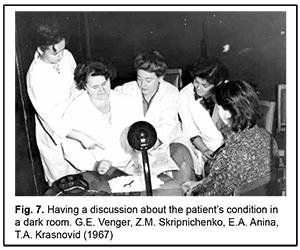 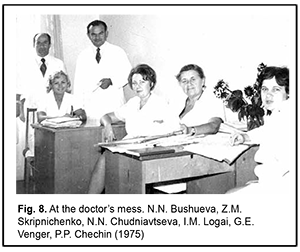 In parallel with this, Z.M. Skripnichenko continued her work to complete her doctoral dissertation, with the subject that had been recommended previously by V.P Filatov, a research on ocular toxicity of tetraethyl lead (TEL), a gasoline additive used to boost octane number. As a result, an animal model of toxic TEL-induced glaucoma was built. In order to obtain clinical data, the researcher travelled on long business trips to the city of Gorkii. Elastometry was performed on refinery workers directly at their working places. The study demonstrated impaired IOP regulation and the development of toxic glaucoma caused by TEL poisoning in workers with a long service record. In 1962, Z.M. Skripnichenko successfully defended her doctoral dissertation, “Toxic glaucoma caused by tetraethyl lead poisoning”. Foreigners became interested in this research, and the topic of toxic tetraethyl lead glaucoma was accepted for presentation at the 19th International Ophthalmology congress in New Delhi in 1962. In 1968, a report on the study on toxic glaucoma was published in a foreign journal, Acta medica academiae scientiarum hungaricae [3], which was rare at that time. Tetraethyl lead fuel additives were phased out in many countries. Subsequently, the issues related to ocular injuries due to toxic exposure and the prevention of these injuries in industrial workers (particularly, miners) and agricultural workers were studied [4]. Much attention was given by Z.M. Skripnichenko to the methods of diagnosis and treatment of eye trauma, especially penetrating globe injuries with an intraocular foreign body (IOFB). Particularly, the methods for X-ray plus ultrasound localization of IOFB were developed in collaboration with R.K. Marmur, S.A. Liubarskii, and I.Ia. Shitova. Ultrasound biometry measurements of the anterior length of the eye allowed for the introduction of corrections into the results of X-ray measurements using the Komberg-Baltin prosthesis and assuming the typical axial length of 24.0 mm. This methodology was especially important for the cases with an IOFB located in the interface of the eye [5]. Locations of lens foreign bodies in traumatic cataracts were assessed in collaboration with G.V. Panfilova and R.K. Marmur [6]. Close collaboration with Professor R.K. Marmur has resulted in the development of an ultrasound technique for the detection of radiolucent IOFB [7] and offering the opportunity for ultrasound assessment of the anterior eye in patients with a traumatic cataract [8]. The developed imaging techniques have been introduced in ocular traumatology as routine examination techniques and are still in use. Ivan M. Logai, a pupil of Z.M. Skripnichenko, dealt with issues of the treatment of patients with IOFB. He successfully defended his doctoral dissertation on the removal of IOFB from a transparent lens (through the use of cobalt-samarium magnet) and the posterior eye (through the use of electric welding), and subsequently for years was the head of the Filatov Institute. Z.M. Skripnichenko with collaborators performed a multifaceted research on reconstruction of shells of the damaged eye. Adequate treatment of corneal wounds was important. 10/0 atraumatic nylon sutures for corneal wounds were unavailable at that time, whereas the available biosutures and needles with a large needle eye had numerous disadvantages. This led for a search for a new technique of securing the corneal wounds. An adequate formulation of cyanocrylate adhesive was found and advantages of combining sutures with adhesive wound closure strips were demonstrated in an experimental study [9]. It was recommended to incorporate antibiotics into the adhesive formulation in applications for infected wounds, and a great deal of research has been conducted on the treatment of corneal wounds using various types of keratoplasty - from superficial curative keratoplasty to keratoplasty with a scleral rim [10]. Solutions for issues related to homoplastic scleral strengthening surgery in patients with eye trauma and patterns of surgical debridement of penetrating injuries were developed in collaboration with Academician N.A. Puchkovskaia. A methodology was developed to remove a non-metallic IOFB embedded in the deep cornea and anterior chamber [11]. Post-traumatic iris pathology (iridodialysis, coloboma, iris deformity, iris displacement, and occlusio puppilae) not only affects the functions of the eye after trauma, but also is a cosmetic defect. Z.M. Skripnichenko was a pioneer of reconstructive iris surgery [12]. The Eye Trauma Clinic has been performing iris surgeries since 1967. Commonly iris surgery was performed in combination with traumatic cataract extraction. Original methods for surgical repair of traumatic mydriasis [13] and for the formation of the pupil in case of seclusio papillae or occlusio papillae [14] were developed. In retrospect, this were rather adventurous procedures for the time, as sutures were placed on the iris in the presence of direct contact, which was achieved by folding back the corneal flap after making a rather large limbal incision (as large as 10-11 mm). The first clinical studies, however, demonstrated that traumatic defects of the iris can be repaired surgically. In addition, in some patients, surgeons managed to form the pupil in the presence of a normal lens. Z.M. Skripnichenko delegated the topic of “the surgical repair of traumatic defects of the iris” to G.E. Venger, a young candidate of science in medicine, who succeeded by successfully defending her doctoral dissertation and subsequently took the chair of Ophthalmology at the Medical University of Odessa. The issues related to traumatic cataract comprised a large portion of research by Z.M. Skripnichenko. She conducted studies on aqueous exchange and IOP in contusion cataracts (in collaboration with E.I. Anina), aniseikonia (in collaboration with I.A. Viazovskiĭ), and restoration of binocular vision in unilateral aphakia using glasses and contact lenses (in collaboration with Iu.A. Golubenko), as intraocular lenses were not yet developed at the time of the study. In addition, the role of inflammation in posttraumatic streptococcus-associated uveitis was investigated [15]. The major portion of research was, however, dedicated to the technology of traumatic cataract extraction. Professor Z.M. Skripnichenko published more than two dozen of works on this subject during 1964 to 1983. Management of traumatic lens dislocation was a challenge at that time. As early as the nineteen sixties, Duke-Elder (1954), Barrаquer (1953) and other outstanding ophthalmologists of that time concluded that the surgical removal of a traumatic dislocated lens was the most favorable treatment option. Although there was agreement on the surgical removal of a lens dislocated into the anterior chamber, there was disagreement on the management of a lens dislocated into the vitreous. This led to a search of the method of making the lens float in the anterior vitreous, as vitrectomy had not been invented yet at the time. Fixation of a dislocated lens with a special needle with the patient turned to the prone position was suggested (Barrаquer, 1958; Calhoun, Hagler, 1960; Fyodorov, 1962 etc). Given that performing surgery with the patient turned to the prone position constitutes a danger for the eye, Z.M. Skripnichenko suggested the method with the patient in the supine position, with preliminary sclerectomy or trepanocyclodialysis (in the presence of secondary glaucoma) [16]. Lens release was achieved by vitrectomy (using scissors and forceps), the floated lens was removed with a loop, and the elasticity of the eye was restored with balanced salt solution. The success rate of the procedure was 50%, and the method was really ahead of its time [17]. While concluding the discussion on intracapsular and extracapsular cataract extraction, based on the analysis of opinions expressed by many outstanding ophthalmologists of the time (V.V. Volkov, M.N. Krasnov, N.A. Puchkovskaia, T.I. Eroshevskii, V.I. Cherednichenko, A.I. Dashevskii, M.A. Penkov, S.I. Petrunia, etc.), Professor Z.M. Skripnichenko acknowledged that “currently, intracapsular cryoextraction of cataract is a common and highly available surgical option of cataract extraction”. However, a modern approach to extracapsular cataract extraction (extracapsular cataract extraction through phacoemulsification) was also mentioned in that review. The establishment of a unified eye trauma care system in Ukraine, with the involvement of the Republican Ocular Trauma Center and ocular trauma centers in the regions and cities, should be considered the professor’s most important contribution to national healthcare. This was the first national eye trauma care system in the world. The two military physicians, Acad. N.A. Puchkovskaia and Professor Z.M. Skripnichenko, knew well the war-time system of providing care to the wounded which had been based on the guidelines developed by N.I. Pirogov and involved triage, transportation and tertiary care (for casualties with severe injuries). As they knew from their own experience that the system produced good results, the system was used as the basis on which the unified eye trauma care system was developed. This lead to a thoughtful and multifaceted work aimed at developing a multilevel system of eye trauma centers. Some articles [19, 20] were published and reports presented at conferences [21] on the need for establishing advanced forms of organization to provide eye trauma care to the injured. The propositions for organizing a system of eye trauma care were reported at meetings both at the Ministry of Health and at the government level. The general approval led to the elaboration of principles specifying who, when, where and in what extent should provide care to individuals with injuries and burns to the eye [22]. This resulted in issuing a ministerial decree on establishing regional eye trauma care centers and a republican ocular burn and trauma center at the Filatov Institute. The decree enabled equipping the centers with modern microscopes and microinstrumentarium. Eye trauma specialists were trained at the Ocular Trauma Department (at the Filatov institute), microsurgery courses, and physician refresher courses on the diagnosis and treatment of eye diseases (Fig. 9). The courses usually combined a didactic component (lectures on the latest advances in the field) with hands-on cadaver and/or vivarium training related to microsurgical processing of corneal and scleral injuries, methods of iris plastic surgery, lens aspiration and anterior vitrectomy. Actually, these were the first vet labs in Ukraine, and today, vet labs are widely used by ophthalmologists across the globe for mastering various eye surgery procedures. In 1978, the methodological guidelines on the operation of ocular trauma centers were published which specified the indications for (1) referring patients to the ocular trauma centers in the regions and the Republican Ocular Trauma Center without performing intermediate phases of treatment as well as (2) the nature of microsurgical interventions to be performed at these centers [23]. In addition, the guidelines were related to the issues of registration and analysis of eye trauma cases, prevention measures, personnel training, and building the capacity of the centers. The results of this enormous work were soon seen. The performance of primary surgical processing at the microsurgical level by well-trained specialists resulted in a significant decrease in enucleation rate as well as the incidence of registered disability associated with eye trauma. Based on the analysis of five-year performance of secondary and tertiary emergency eye trauma centers of the Ukrainian SSR, this pattern of organization of emergency eye trauma services was considered appropriate, and recommended for implementation in other republics of the USSR [24]. In general, this work greatly facilitated mastering microsurgical techniques for any eye disorder in Ukraine, because the available equipment, instrumentarium and well-trained personnel were involved not only in the provision of emergency eye care, but also in scheduled eye surgeries. The Ocular Trauma Department has become a leader not only among the departments of the Filatov institute, but also on a national level. It has become the first department in the country to introduce the techniques of cataract phacoemulsification, intraocular lens implantation, and pars plana lensvitrectomy, let alone advanced methods of reconstruction for patients with severe globe trauma.
Even after a well-deserved retirement, Professor Z.M. Skripnichenko continued working in her field of interest. She wrote a monograph entitled “Occupational eye diseases” in collaboration with Z.A. Alieva and A.P. Nesterov [25]. The material she had prepared on toxic cataracts was used in a monograph on cataracts which she wrote in collaboration with Professor N.F. Bobrova [26]. Her memoirs about Academician Filatov were published in various newspapers and journals. Professor Z.M. Skripnichenko was an active participant in the establishment of a museum complex commemorating her dear teacher, Academician Filatov [27]. The year 2014 marked her 100th anniversary, and she received numerous flowers and congratulations from the city administration, the institute, her friends and family (Fig. 11). So how did this girl, born in a time of historic upheavals and coming from a non-medical family, manage to become so highly professional? Certainly, having natural gifts is important, but “a jewel will not shine if it is not polished”, as an old Japanese proverb says. Tireless work, striving for innovations, curiosity, quality characters firing, serving in the army during the war, guidance from a genius teacher, maintaining good contacts with professors of the Filatov’s school, benevolence, and attention to and compassion for everyone around her…This is an incomplete list of the “polishing mechanisms” making her natural gift shining so brightly. Professor Z.M. Skripnichenko created a Ukrainian school of ocular traumatology and brought up a group of brilliant microsurgeons (three doctoral dissertations and ten candidate of science theses were defended under her guidance). The system of ocular centers that was created functions well and evolves as needed. Today it is the pupils of her pupils that contribute to advances in eye trauma surgery.
References 1.Markovskii PP. [Imprint on the Earth]. Kamianets-Podolskii; 2013. Russian. 2.Iartseva NS, Luchevich EE. [History of ophthalmology in persons, events and articles]. Moscow: April; 2014. Russian. 3.Skripnichenko ZM. [Toxic Tetraethyl lead glaucoma]. Acta Med Acad Sci Hungar. 1968;25(2):175–84. Hungarian. 4.Skripnichenko ZM. [On occupational eye diseases under conditions of industrial poisoning]. Oftalmol Zh. 1970;25(8):566-9. Russian. 5.Skripnichenko ZM, Shitova IIa, Liubarskiĭ SA. [Assessment of foreign body detection in the interface of the eye by X-rays versus roentgenography combined with ultrasound]. In: [Proceedings of the 8th interregional conference]. Lvov, 1965. Russian. 6.Skripnichenko ZM, Panfilova GV, Marmur RK. [Clinical efficacy of the comprehensive detection of lens foreign bodies in traumatic cataracts]. Kyiv: Zdorovia; 1971. Russian. 7.Marmur RK, Skripnichenko ZM. [Ultrasonic diagnosis of X-ray negative foreign bodies in the anterior region of the eye]. Oftalmol Zh. 1968;23(8):575-9. Russian. 8.Marmur RK, Skripnichenko ZM, Iakimenko SA. [Evaluation of the state of the anterior part of the eye in patients with traumatic cataracts using the method of ultrasonic echography]. Oftalmol Zh. 1970;25(3):192-8. Russian. 9.Skripnichenko ZM, Bushueva NN, Dumbrova NE. [Experimental use of a cyacrin glue composition for uniting open wounds of the cornea]. Oftalmol Zh. 1970;25(5):367-70. Russian. 10.Skripnichenko ZM, Logaĭ IM, Bushueva NN. [Keratoplasty in infected corneal wounds]. Oftalmol Zh. 1978;33(2):96-100. Russian. 11.Skripnichenko ZM. [Removal of nonmetallic foreign bodies from the deep layers of the cornea with partial protrusion into the anterior chamber]. Oftalmol Zh. 1969;24(1):37-41. Russian. 12.Skripnichenko ZM. [Operations on the iris in traumatic lesions of the eye and their sequelae]. Oftalmol Zh. 1972;27(7):502-5. Russian. 13.Skripnichenko ZM. [A method of surgical treatment of traumatic mydriasis]. 1974. Inventor's certificate № 464310. Russian. 14.Skripnichenko ZM. [Operation for the formation of the pupil in its adhesion and atresia]. 1974. Inventor's certificate №439285. Russian. 15.Skripnichenko ZM, Borovkova NG, Kuksa VD, Koschcheeva GM. [A method of treatment of streptococcus-associated infective and allergic uveitis]. 1973. Inventor's certificate №400324. Russian. 16.Skripnichenko ZM. [Current status of treatment of traumatic luxations of the lens]. Oftalmol Zh. 1977;32(3):163-70. 17.Skripnichenko ZM, Logaĭ IM. [Anterior vitrectomy and excision of adhesions during extraction of complicated traumatic cataracts]. Oftalmol Zh. 1976;31(7):483-7. Russian. 18.Skripnichenko ZM. [Discussion on intra- and extracapsular cataract extraction]. Oftalmol Zh. 1978;(6):463-7. Russian. 19.Puchkovskaia NA, Skripnichenko ZM. [Necessity of using more effective forms of organization of treatment of eye injuries and their sequelae]. Oftalmol Zh. 1975;30(2):102-5. Russian. 20.Skripnichenko ZM, Nepomiashchaia VM. [Organization and methods of restorative treatment in damage to the organ of vision]. Oftalmol Zh. 1975;30(7):500-4. Russian. 21.Puchkovskaia NA, Ferfil'faĭn IL. [Republican interdepartmental meeting on the prevention of eye trauma and registered disability associated with eye trauma in the Ukrainian SSR]. Oftalmol Zh. 1975;30(8). Russian. 22.Puchkovskaia NA, Skripnichenko ZM, Ferfil'faĭn IL. [Necessity of organizing a unified system of medical rehabilitation of the visually handicapped in the Ukrainian SSR]. Oftalmol Zh. 1978;33(3):182-5. Russian. 23.Puchkovskaia NA, Skripnichenko ZM, Legeza GV, Logaĭ IM, Nepomiashchaia VM. [Methodological instructions on the work of eye injury centers]. Oftalmol Zh. 1978;33(5):388-95. Russian. 24.Puchkovskaia NA, Skripnichenko ZM, Logaĭ IM. [Rendering emergency care in eye injuries and the further tasks of eye trauma centers]. Oftalmol Zh. 1982;37(7):388-91. Russian. 25.Alieva ZA, Nesterov AI, Skripnichenko ZM. [Occupational eye diseases]. Moscow: Meditsina;1988. Russian. 26.Bobrova NF, Skripnichenko ZM. [Toxic, congenital and secondary cataracts]. Odessa: Izdatelskii tsentr; 2017. Russian. 27.Kovalenko NB. [Pages in our history …]. Odessa; 2018. Russian.
|

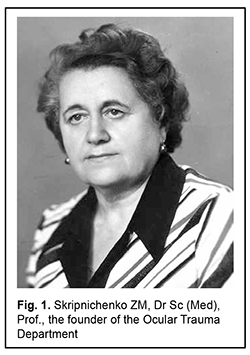
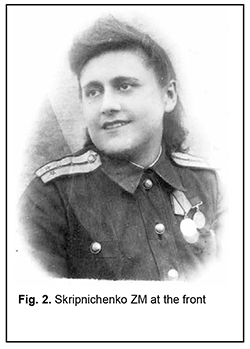
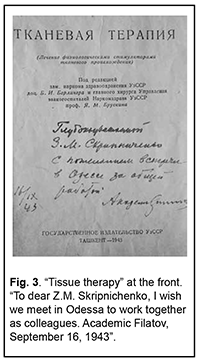 So why did Z.M. Skripnichenko deserve to be called the founder of Ukrainian ocular traumatology? After all, at that time, in Ukraine, there were many science schools and prominent researchers working in this field. Researchers from the Kharkiv Hirshmann Research Institute of Eye Diseases and the Department of Eye Diseases at Kharkiv Medical Institute have contributed to advances in the treatment of ocular trauma (I.I. Merkulov, V.I. Cherednichenko, Z.F. Belousova); research on the pathogenesis of the wound process in the eye (N.E. Braunshtein, M.I. Penkov); methods of surgical and conservative treatment (S.V. Sukhov, E.V. Davydova, N.S. Kharon); and industrial, agricultural, domestic and pediatric ocular injuries. In addition, there have been contributions to advances in roentgen equipment for foreign body detection (Iu.I. Bogdanova, S.M. Pochtman, I.P. Guliaieva, etc.). Among the researchers of the Kyiv school of ophthalmic science, F.V. Prpichek contributed to the research of contusion to the globe, and I.A. Korenevich was the first Ukrainian ophthalmologist to point to the diascleral removal of magnetic foreign bodies from the eye. P.S. Plitas has been working on the removal of non-magnetic foreign bodies from the anterior chamber angle. S.N. Smirnov has proposed a wireless technique for X-ray foreign body detection. N.I. Pilman has raised the issue of employment of the disabled veterans of the war. The Donetsk school of ophthalmic science contributed to the research on industrial ocular injuries. Particularly, they have been conducting studies to advance the methods of care for patients with intraocular foreign bodies (G.A. Dugelnyi and I.F. Klopp), the application of keratoplasty, (A.S. Gmyria and S.P. Petrunia), surgical wound debridement (V.A. Paneva), and prevention of eye trauma (O.M. Matiashina, V.P. Skripka, P.A. Rudenko). The establishment of Donetsk Research Institute of Traumatology and Orthopedics incorporating the Eye Trauma Clinic in 1956 was an important event. Studies on ocular trauma have been conducted also in other regions of Ukraine. Particularly, those related to pediatric trauma have been conducted in Vinnitsa (V.I. Kokriatskaia), studies on new eye suturing techniques, in Cherkassy (B.L. Radzikhovskyi), and agricultural ocular trauma, in Chernigov (F.I. Fedchenko). Many other Ukrainian ophthalmologists not mentioned above have been working in this field.
So why did Z.M. Skripnichenko deserve to be called the founder of Ukrainian ocular traumatology? After all, at that time, in Ukraine, there were many science schools and prominent researchers working in this field. Researchers from the Kharkiv Hirshmann Research Institute of Eye Diseases and the Department of Eye Diseases at Kharkiv Medical Institute have contributed to advances in the treatment of ocular trauma (I.I. Merkulov, V.I. Cherednichenko, Z.F. Belousova); research on the pathogenesis of the wound process in the eye (N.E. Braunshtein, M.I. Penkov); methods of surgical and conservative treatment (S.V. Sukhov, E.V. Davydova, N.S. Kharon); and industrial, agricultural, domestic and pediatric ocular injuries. In addition, there have been contributions to advances in roentgen equipment for foreign body detection (Iu.I. Bogdanova, S.M. Pochtman, I.P. Guliaieva, etc.). Among the researchers of the Kyiv school of ophthalmic science, F.V. Prpichek contributed to the research of contusion to the globe, and I.A. Korenevich was the first Ukrainian ophthalmologist to point to the diascleral removal of magnetic foreign bodies from the eye. P.S. Plitas has been working on the removal of non-magnetic foreign bodies from the anterior chamber angle. S.N. Smirnov has proposed a wireless technique for X-ray foreign body detection. N.I. Pilman has raised the issue of employment of the disabled veterans of the war. The Donetsk school of ophthalmic science contributed to the research on industrial ocular injuries. Particularly, they have been conducting studies to advance the methods of care for patients with intraocular foreign bodies (G.A. Dugelnyi and I.F. Klopp), the application of keratoplasty, (A.S. Gmyria and S.P. Petrunia), surgical wound debridement (V.A. Paneva), and prevention of eye trauma (O.M. Matiashina, V.P. Skripka, P.A. Rudenko). The establishment of Donetsk Research Institute of Traumatology and Orthopedics incorporating the Eye Trauma Clinic in 1956 was an important event. Studies on ocular trauma have been conducted also in other regions of Ukraine. Particularly, those related to pediatric trauma have been conducted in Vinnitsa (V.I. Kokriatskaia), studies on new eye suturing techniques, in Cherkassy (B.L. Radzikhovskyi), and agricultural ocular trauma, in Chernigov (F.I. Fedchenko). Many other Ukrainian ophthalmologists not mentioned above have been working in this field.